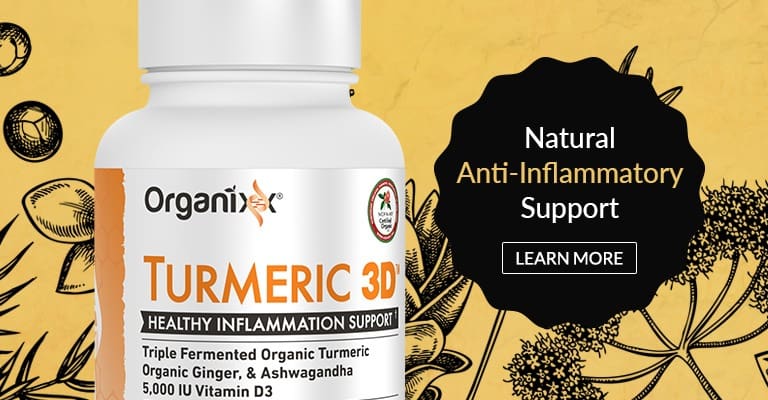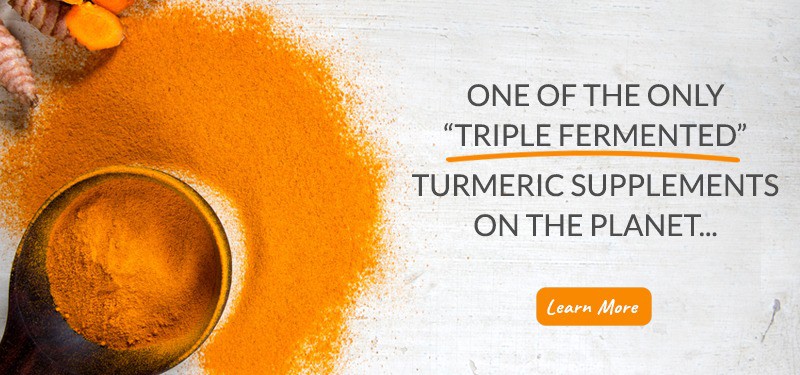Video Transcript:
Today, I’m going to share with you several key and important foods that you can use to support your lymphatic system. One of the things I’m really excited to share with you, I actually have a background and credentialing in supporting patients’ lymphatic systems. I’m a lymphatic drainage therapist, and I actually educate medical providers, I train them on how to support the lymphatic system of their patients. And there are certain disorders and diseases of the lymphatic system that I specialize in.
This, for many of my patients, tends to be a broken record, what I’m going to say, but I’m really excited to share these tips. If they’re new to you, they’re going to greatly enhance your lymphatic process. And before I get into these specific foods, it is really important that every day you seek to choose activities and lifestyle practices that will support your lymphatic system. And why is the question that I often hear from patients.
Why it’s Important to Support Lymphatic Flow
Your lymphatic system is a dual player in your body. It has a core function of supporting your immune system, your immune state. So, if your immune system’s a little weak, or it’s gone haywire and it’s attacking, you’ve got autoimmunity, your lymphatic system’s really important to support.
And then, also, it’s what is our garbage disposal system. It’s our toxic waste removal process. And we often will see through sweat, we remove toxins, and we excrete them through kidneys and the bowels. So, if you find you might be a little bit more toxic, you have a weaker immune system, these foods and adding them in on a daily basis, and sometimes multiple times throughout the day, you are going to really enhance your lymphatic process. So, I’m really excited, because these things are powerful, and I recommend them all the time to my patients.
1. Powerful Anti-Inflammatory Herb Duo
So, number one is a duo of herbs that I absolutely adore. There’s a lot of clinical research in terms of their anti-inflammatory properties and the capacity for them to enhance and speed up the lymphatic flow. And with the lymphatic system, we actually need to employ things that will move the fluid in a healthy way.
So, ginger and turmeric. Those two herbs are the herbs I’m recommending, and they are really powerful at supporting your lymphatic process. Ginger you can add as a powder, you can mix it into certain foods. I make ginger tea. Same with turmeric. Turmeric has a really nice blend with ginger, so there are often teas that you can find that have turmeric, ginger. There’s golden milk, if you’re not familiar with that. I love golden milk to have at night and add to your nighttime routine.
But ginger and turmeric, for my patients, when I recommend two to three cups of ginger and turmeric tea on a daily basis, they notice intensive fluid reduction. So, even if you’re holding on to a little excess water weight, maybe you want to drop two or three pounds, a lot of times it’s fluid. And enhancing your lymphatic process will greatly support that. And you’ll notice a reduction in that fluid retention.
2. Pineapples
And similarly to the fluid retention processes of ginger and turmeric, pineapple. Particularly the enzyme bromelain in pineapple is fantastic for enhancing lymphatic process.[1] I love to use pineapple, fresh, chopped up. You can puree it, you can even squeeze it and have the pineapple juice. It is wonderful, particularly bromelain, at enhancing the blood flow process that is connected to the lymphatic system.
So, often with patients who bruise easily, or the bruise is there for a long period of time, maybe they’ve gone through surgery and we need to minimize the bruising… And patients who have chronic vascular insufficiency, it’s called CVI. And there’s a direct pairing between CVI and your lymphatic system, because CVI, chronic vascular insufficiency, is where there’s a pooling of excess red blood cells. And the red blood cells don’t get swept up and taken and transported by the vascular system. They actually leak into the lymphatic system.
And it’ll often be seen on individuals’ legs from two or three inches below the knee down to the ankle. And it’s this reddish kind of rusted color, and it’s blood cells that are just stagnant. Pineapple is what we can use to really enhance that process. And pineapple is great, as well, for fluid reduction. And I just love the bromelain. The action of bromelain is very supportive of your lymphatic flow.
3. Citrus Foods
The third food group here are citrus foods. We are referencing here grapefruit and assorted oranges, tangerines, limes, and lemons, and even the mix of them. So, having a lemon-lime tea or juicing an assortment of your citrus foods and infusing them into water, that’s what I recommend. And what we used to serve at my wellness center was a blend of citrus fruits.
4. Cranberry
And then with that, I actually add in a fruit called cranberry. And cranberry is a really powerhouse supportive food for your lymphatic system, because cranberry is a fat emulsifier. And cranberry helps move excess fat that is in your lymphatic system. It helps it move out. And your lymphatic system does get rid of fat cells. So, that’s really important, because we don’t want them to get sticky. We want them to be mobile. And the emulsification, that process through cranberry, helps get the flow moving and decongest that system.
5. Dandelion Greens
Now, another thing that you can add to your daily diet, and you could use tincture, you could use the greens, or you could make teas, are dandelion. Using dandelion greens, I love, in your regular salads. And then also brewing up dandelion tea is very supportive of your lymphatic system, because it moves bile out of the liver. So, it’s a very pro-liver supportive herbal.
But in the process of bile production, bile moves toxins out of your digestive process. And one of the most comprehensive, complex structure, of the lymphatic system – the lymphatic vessels and the lymph nodes – the bulk of it is in your digestive process. So, moving your bowels and getting bile moving via dandelion tea actually supports your lymphatic process. And the act of bowel contents moving through the small and large intestine actually motivate your lymphatic system. It’s something that a lot of people don’t realize, but when you’re constipated, you’re not getting that lymphatic movement in the lower torso.
6. Omega-3-Dense Foods
Next, I recommend eating healthy fats, particularly omegas. Omega-3-dense foods, reaching for chia seeds and flax seeds and hemp oil. These are going to be all good things. Healthy fat in your fish, healthy proteins, even nuts and seeds are going to really give your body the healthy fats that it needs to reduce inflammation, which tends to bog down the lymphatic system. So, that is a secondary byproduct of supporting the lymphatic system. So, we lower our inflammatory factors by enhancing healthy fats in your daily intake.
7. Nettle Tea
Now, another tea that I love to recommend is nettle. Nettle is a lesser-known tea that’s fantastic for the lymphatic system, but it is so powerful at moving fluid. It really gets the kidneys and the bladder engaged. And a lot of folks do notice slight reduction in fluid retention. It’s not as powerful, I will say, as ginger and turmeric. Those are my number ones. But nettle is highly effective at just overall supporting your lymphatics.
8. Fermented Foods: Prebiotics and Probiotics
And then last and final, reach for fermented food. So, you want to reach for kimchi and your kefir and beet kvass, miso – all of the fermented foods that are going to be prebiotic and probiotic dense. That really helps support the digestive process. And the more we can support our digestive process, because the bulk of our lymphatic structure is in the gut, then it really helps to support that whole gut process and lymphatic flow.
So, those are my food tips today, and I know these will be really helpful, and I look forward to hearing which ones you try, and which ones you find the most effective for your own body.
Turmeric 3D from Organixx provides you one of the most “bioavailable” forms of turmeric due to its unique fermentation process. This means your body experiences the maximum benefits of the purest, most potent turmeric available!
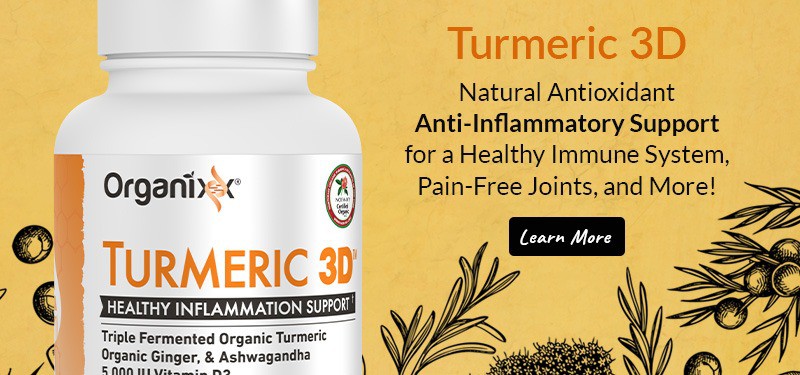
You’ve likely heard about the many health benefits of turmeric (Curcuma longa L.) and its compound curcumin. But did you know that it can be difficult to “unlock” the nutrients in turmeric so your body can actually take full advantage of them?
One popular way to make the compounds in turmeric more bioavailable (i.e., absorbable and usable to the body) is to pair it with another popular cooking spice: black pepper [1]. But what if there was a better way to improve absorption of curcumin than combining turmeric and black pepper? A way to boost turmeric’s bioavailability, allowing it to more safely and effectively support the natural healing process?
The Healing Power of Turmeric
Turmeric is a staple remedy from the traditional medicine systems of the Far East. Out of all herbs and spices, it seems like turmeric has gained the most widespread popularity as a “super” spice in the West in recent years.
Turmeric’s many health-supportive properties are attributed to curcumin, a key component of turmeric that’s been studied extensively for its:
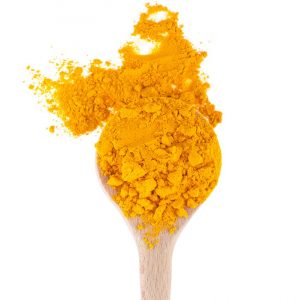 anti-inflammatory properties
anti-inflammatory properties- antioxidant properties
- impact on longevity
Curcumin is documented in the scientific literature as offering powerful support for the cardiovascular, neurological, metabolic, immune, and cellular systems. It’s also the part of turmeric that gives this root spice its rich, golden yellow color.
But the truth of the matter is that humans have a difficult time getting all the health benefits from turmeric when consuming the spice all by itself. Research shows that only a very small portion of its active ingredient (compound) is assimilated into the body when eaten in isolation.
Turmeric and Black Pepper Benefits
This is why many natural health experts suggest consuming turmeric along with black pepper (Piper nigrum). Black pepper contains a unique “bio-enhancer” compound known as piperine that significantly boosts turmeric’s bioavailability – by as much as 2,000 percent, in fact.
This is the reason why many turmeric and curcumin supplement products on the market today contain either black pepper or piperine.
The Problem: Black Pepper Isn’t Good for Everyone
This pairing approach of turmeric with black pepper (or curcumin with black pepper) comes with limitations, however, as too much black pepper can actually be detrimental to health – especially in people with gastrointestinal issues.
 Research published in the American Journal of Gastroenterology found that consuming black pepper in excess can damage the mucosal lining of the gut, potentially causing bleeding or other injuries.
Research published in the American Journal of Gastroenterology found that consuming black pepper in excess can damage the mucosal lining of the gut, potentially causing bleeding or other injuries.
Consuming high amounts of black pepper, this same study found, is akin to taking the painkiller drug aspirin [2]. In other words, aspirin (along with other non-steroidal anti-inflammatory drugs such as ibuprofen) represents a similar threat to the gut lining in terms of its tendency to cause serious erosions and ulcers in the intestinal tract [3].
This isn’t to say that black pepper is inherently dangerous, and there’s no need to toss out the pepper shaker just yet. After all, the amounts of black pepper required to induce such harm are far greater than what the average person consumes in their food on a daily basis.
There’s also evidence to show that taking curcumin along with just piperine, black pepper’s primary alkaloid, is typically safe and causes “no adverse effects [4].”
Even so, there’s always the possibility that someone might react negatively to this combination – especially when taking very high doses of turmeric or curcumin for therapeutic purposes.
For this reason, science set out to determine whether or not it was possible to retain turmeric’s full bioavailability without the need for black pepper, piperine, or any other additive. And the good news is, it is possible.
Fermentation Increases the Bioavailability of Turmeric BETTER Than Black Pepper
As it turns out, by fermenting turmeric its active constituents can be drawn out and made more potent in a way similar to, and potentially even greater than, black pepper.
Here’s another reason why fermented turmeric may be superior to turmeric and black pepper. Besides possibly upsetting a person’s digestive system, black pepper is known to interfere with a process known as glucuronidation that’s necessary for eliminating toxins from the body [5].
Put simply, too much black pepper can cause a buildup of xenoestrogens (harmful chemicals found in plastic and other everyday products) and other toxins that would otherwise be quickly eliminated from the body [6].
With simple fermentation, however, there’s little-to-no risk of these types of complications. That’s because there’s nothing like black pepper getting in the way to block the body’s important detoxification pathways.
It’s rather like eating fresh turmeric, which still contains all of the volatile (essential) oils that help to deliver the herb’s active compounds throughout the body. Fermentation may even go a step beyond this by further optimizing turmeric’s absorption potential.
Research conducted on rat models found that fermented turmeric is, indeed, the best form of turmeric because it contains the most antioxidant power. Compared to ground turmeric in powder and probiotic forms, fermented turmeric led to substantially higher plasma antioxidant concentrations in test subjects [7].
In terms of how it affects the liver, fermented turmeric was shown in a 2013 paper out of South Korea to be powerfully hepatoprotective, meaning it shields the liver from damage.
Not only that, but fermented turmeric was also shown to help improve the liver’s functional detoxification potential [8] – as opposed to black pepper-potentiated turmeric that can inhibit natural detoxification.
Fermented turmeric also contains more curcumin (the beneficial compound) than unfermented turmeric, by volume. In addition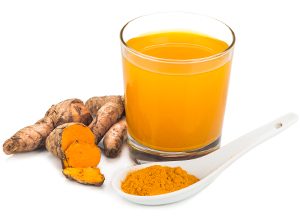 to improving both its antioxidant and antimicrobial capacity, fermenting turmeric draws out an impressive 11% more curcumin compared to what’s found in raw turmeric.
to improving both its antioxidant and antimicrobial capacity, fermenting turmeric draws out an impressive 11% more curcumin compared to what’s found in raw turmeric.
Fermentation also makes turmeric 3.1 times more effective at scavenging oxidizing free radicals from the body [9].
Another area where fermented turmeric has a leg up on both unfermented turmeric and turmeric combined with black pepper is in the area of inflammation.
Research published by The Korean Society for Applied Microbiology and Biotechnology in 2011 found that fermented turmeric is a powerful anti-inflammatory, possessing the ability to inhibit pro-inflammatory cytokines much more effectively than any other known form of turmeric. Fermented turmeric was further shown in this same study to protect against acute anaphylactic, or allergic, reactions [10].
From an antimicrobial perspective, fermented turmeric shows incredible potential against a wide variety of pathogenic bacteria, including drug-resistant “superbugs.”
Research out of the Middle East in 2016 found that fermented turmeric provides broad-spectrum protection against harmful bacteria such as Escherichia coli (E. coli), Streptococcus agalactiae, Staphylococcus aureus (Staph), Entreococcus faecalis, Methicillin-Resistant Staphylococcus aureus (MRSA), Klebsiella pneumonia, and Pseudomonas aeruginosae [11].
Earlier research out of China found that fermented curcumin can be a powerful weapon against high cholesterol, also known as hyperlipidemia. While unfermented curcumin showed minimal-to-no benefits during the evaluation, its fermented counterpart significantly reduced serum lipid levels in animal test models [12].
Fermented Turmeric Increased Fat Loss in Animal Test Subjects
 Fermented turmeric also shows promise in fighting another undesirable form of fat: the obesity kind.
Fermented turmeric also shows promise in fighting another undesirable form of fat: the obesity kind.
Research out of South Korea in 2015 found that consumption of fermented turmeric can alter the expression of certain genes involved with lipid accumulation, effectively preventing them from communicating to the body that it’s time to pack on extra pounds [13].
Related research published a year later, also out of South Korea, reiterated these findings while building upon them. Obese rats fed a high-fat diet not only didn’t gain more weight when also consuming fermented turmeric, but they further lost weight as a result of consuming the herb as part of their daily eating routines [14].
Preventing Impairment of Learning and Memory
Research has shown that fermented turmeric can also play a role in brain health. Among the findings fleshed out in a 2017 paper published in the journal BMC Complementary and Alternative Medicine was evidence suggesting that fermented turmeric has the potential to mitigate memory impairment while supporting optimized learning and memory ability in mice [15].
While more research needs to be done, the evidence so far seems clear… fermentation is the key to “unlocking” the incredible healing potential of turmeric, while avoiding the potential side effects of combining turmeric and black pepper.


